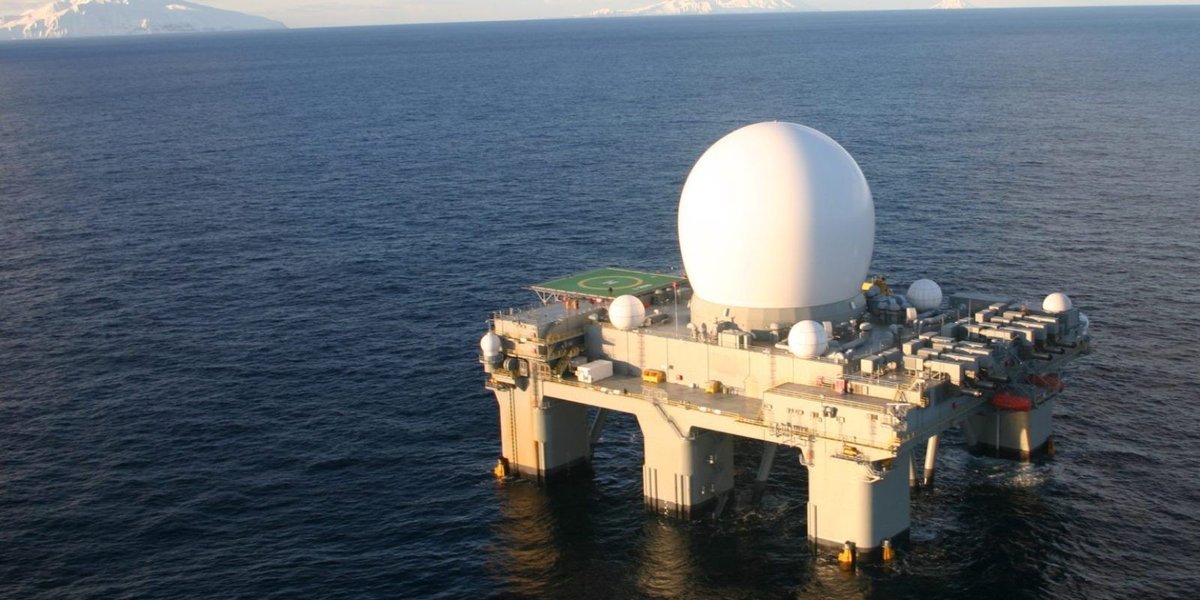THE SEA-BASED X-BAND RADAR FLOATS AROUND HELPING US DETECT NUKES
By Buddy Blouin

Advertisement
Forward operating bases (FOBs) became popular in the mainstream after seeing military installations in Iraq and Afghanistan through the news. Known for their HESCO barriers to keep out gunfire and explosives, FOBs are used to help troops resupply and communicate with a closer touchpoint. So, you might be surprised to learn that FOBs also exist in America. They are used for training, testing, and in our case today, detecting missiles. The Sea-Based X-band Radar (SBX-1) is a unique FOB floating off in the Pacific Ocean helping make sure we don’t go boom.
Read next: Space Force Is Now Responsible for All Military Satellite Communication
How the Missile Defense Agency Uses the Sea-Based X-Band Radar
America has many different components to keeping nuclear war and missiles at bay. The Missile Defense Agency (MDA) is part of the U.S. Department of Defense (DoD), and its primary role is to ensure that a multi-faceted approach is in place to prevent ballistic missiles from hitting the U.S. or allies abroad. But it's a long way from its headquarters in Fort Belvoir, Virginia, that we find the Sea-Based X-band Radar. A good thing, too, as its positioning is great for both detecting threats on the other side of the world and undergoing testing and maintenance at Pearl-Hickam Harbor. The Sea-Based X-band Radar is based at Adak Island in Alaska, but you can often find it floating off the coast fulfilling its duty as part of the MDA’s Ballistic Missile Defense System. The FOB is self-propelling and can sustain rough seas and high winds while performing its duties. Because the Earth isn’t flat, there are some areas that can result in a blind spot when trying to detect missiles. This is obviously a problem, as the government needs to see all it can to detect ballistic missiles as soon as possible. The SBX-1 helps fix some of this by being capable of moving throughout the ocean. The significance of this feature is huge and should continue to be prominent in the next several years. SBX-1 is used to monitor incoming missiles primarily from North Korea and China but may also be used to detect potential missiles from Russia’s eastern side. As the name would suggest, the FOB uses the X-band's frequencies to detect potential incoming threats. Other bands used by the U.S. Missile Defense System would be the S-band by AEGIS and C-band by Patriot systems.What Is a Ballistic Missile?
A ballistic missile is a weapon that is controlled for a short time after its launch but ultimately uses gravity to strike its target. Often carrying warheads, these missiles, while unpowered, pack a nasty punch and can even deliver nuclear strikes. Short-range ballistic missiles never leave the Earth, but intercontinental ballistic missiles (ICBMs) will reach a sub-orbital flight before striking their target.Advertisement
How Precise Is Sea-Based X-band Radar?
The Sea-Based X-band Radar can detect ballistic missiles as far as 2,500 miles away. SBX-1 has been used to detect missile launches by North Korea. In 2017, it successfully tracked a mock ICBM traveling at the speeds of a regular ICBM. But despite its efforts and improvements, not everyone is sold. “The Pentagon’s $10-Billion Bet Gone Bad” was an article by the Los Angeles Times showcasing, in part, the inadequacies of the SBX-1, despite the $2.2 billion cost of the system. This is due to the Sea-Based X-band Radar’s rough beginnings, which resulted in many maintenance trips to Pearl Harbor. Today, it continues to serve as a part of many other missile defense pieces set up by the DoD. Does it work? We hope so, but more importantly, let’s hope we never actually have to find out. Suggested read: Fort Bragg Solar Array Helps Fight Climate ChangeImage: Missile Defense Advocacy Alliance
Written by
Buddy Blouin
Buddy Blouin is a Contributing Writer at VeteranLife.com
Buddy Blouin is a Contributing Writer at VeteranLife.com
Advertisement
SHARE:



